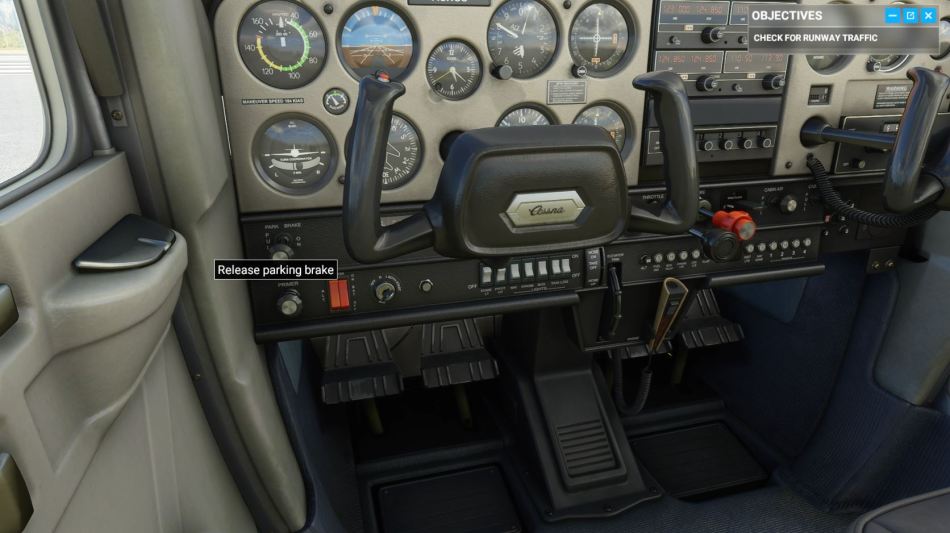Before taking to the virtual skies in
Microsoft Flight Simulator, it's essential to grasp the fundamentals of flight control. This knowledge lays the foundation for a smooth and realistic flying experience.
Understanding Control Surfaces
At the core of flight control are the primary control surfaces: ailerons, elevators, and rudders. Each plays a crucial role in maneuvering the aircraft.
- Ailerons: Located on the wings, ailerons control the aircraft's roll by moving in opposite directions.
- Elevators: Positioned on the tail, elevators control pitch, allowing the nose of the aircraft to move up or down.
- Rudders: Also on the tail, rudders control yaw, enabling the aircraft to turn left or right.
Impact on Flying Experience
Proper utilization of these control surfaces is essential for a realistic and enjoyable flight. The responsiveness of the aircraft to your inputs will determine how well you can navigate the virtual skies.
Coordinating Control Inputs
While mastering individual control surfaces is crucial, effective flying in
Microsoft Flight Simulator requires coordination. Pilots must seamlessly integrate aileron, elevator, and rudder inputs to achieve precise control and execute maneuvers accurately.
Simulator Realism
Microsoft Flight Simulator's commitment to realism extends to its portrayal of flight control. The accurate representation of these control surfaces and their influence on the aircraft's behavior adds an immersive layer to the simulation experience.
Recommended Practice:
Take the time to practice basic maneuvers, such as climbs, turns, and descents, to familiarize yourself with the responsiveness of the aircraft. This foundational knowledge will prove invaluable as you progress to more advanced flying scenarios.
Flight Control in Various Aircraft
It's important to note that different aircraft may have unique characteristics in terms of control responsiveness and behavior. Familiarizing yourself with the specifics of each aircraft type will contribute to a more nuanced and enjoyable flying experience.
Braking Techniques in Microsoft Flight Simulator
As you navigate the virtual skies in
Microsoft Flight Simulator, mastering braking techniques is essential for safe landings, precise taxiing, and overall control of your aircraft. Let's explore the various braking mechanisms and how to effectively use them within the simulation environment.
Overview of Braking Systems
Microsoft Flight Simulator simulates a range of braking systems, including wheel brakes, parking brakes, and anti-skid systems. Understanding these components is crucial for executing smooth and controlled stops on the runway or taxiway.
Keyboard and Joystick Integration
For virtual pilots using a keyboard or joystick, the integration of braking commands is straightforward. Assigning keys or buttons to control the brakes allows for quick and responsive braking inputs during critical moments, such as landing or taxiing to the gate.
Adjusting Braking Intensity
One key aspect of effective braking is the ability to adjust braking intensity based on the situation.
Microsoft Flight Simulator provides options to modulate brake pressure, allowing for gentle deceleration during taxiing and more forceful braking when needed, such as during an emergency stop.
Common Keyboard Commands for Braking
| Command | Function |
|---|
| B | Apply or release wheel brakes |
| Period (.) | Toggle parking brake |
| Ctrl + . | Apply or release parking brake |
Advanced Techniques for Precise Braking
For virtual pilots seeking more nuanced control,
Microsoft Flight Simulator offers advanced techniques such as differential braking. This involves applying brakes to one wheel more than the other, enabling tighter turns during taxiing.
Addressing Challenges in Different Conditions
Adapting to various weather conditions is crucial for effective braking. Wet or icy runways may require more cautious braking to prevent skidding, while strong crosswinds can influence the aircraft's behavior during landing and taxiing.By mastering the braking techniques in
Microsoft Flight Simulator, virtual pilots can enhance their overall flying experience, ensuring both safety and precision in every aspect of their journey.
Advanced Techniques for Precise Braking
For virtual pilots aiming for the pinnacle of control in
Microsoft Flight Simulator, mastering advanced braking techniques becomes essential. These techniques go beyond the basics, offering a higher level of precision and finesse in managing your aircraft's speed and direction during critical phases of flight.
Differential Braking
Differential braking is a technique that involves applying brakes to one wheel more than the other. This allows for tighter turns during taxiing, especially useful when navigating through congested airport aprons or making sharp turns on narrow taxiways. Pilots can achieve this by assigning separate brake controls to the left and right sides, enabling independent brake application.
Toe Brakes for Nuanced Control
Virtual pilots with more sophisticated hardware, such as pedals equipped with toe brakes, gain an advantage in achieving nuanced control. Toe brakes, separate from the main wheel brakes, provide finer control over the braking force applied to each wheel. This is particularly beneficial during the landing rollout, where precise adjustments are crucial for a smooth and controlled stop.
Optimizing Brake Sensitivity
Configuring the sensitivity of your braking inputs is another advanced technique.
Microsoft Flight Simulator allows users to adjust the sensitivity of their brake controls, tailoring them to personal preferences and the specific characteristics of their input devices. Finding the right balance ensures that braking inputs are responsive without being overly sensitive, allowing for a more customized and enjoyable flying experience.
Challenges in Various Weather Conditions
Advanced braking techniques become even more critical when facing adverse weather conditions. In situations where runways are wet, icy, or covered in snow, pilots must exercise extra caution to prevent skidding. Adjusting the differential braking and carefully modulating brake pressure becomes crucial to maintaining control and ensuring a safe landing or taxiing experience.
Continuous Learning and Practice
Mastering advanced braking techniques is an ongoing process that requires continuous learning and practice. Engaging in regular training sessions and experimenting with different configurations will contribute to a deeper understanding of your aircraft's braking dynamics, ultimately enhancing your ability to handle diverse flying scenarios with precision and confidence.
Frequently Asked Questions (FAQ)
As virtual pilots explore the intricacies of braking in
Microsoft Flight Simulator, common queries often arise. Here, we address some frequently asked questions to provide clarity and assistance for a smoother virtual flying experience.
Q: What should I do if my aircraft skids during landing?
A: Skidding during landing can occur, especially in adverse weather conditions. To mitigate this, reduce your approach speed, ensure proper alignment with the runway, and gently apply brakes. Additionally, consider adjusting brake sensitivity in the simulator settings for more precise control.
Q: Are there specific keyboard commands for emergency braking?
A: Yes, the default keyboard command for applying maximum brake force is the
Full Stop (End) key. This can be useful in emergency situations or when a rapid stop is necessary. Exercise caution, as abrupt braking may result in skidding, particularly on slippery runways.
Q: Can I use an Xbox controller for effective braking?
A: Absolutely.
Microsoft Flight Simulator supports various input devices, including Xbox controllers. Assigning brake functions to specific buttons on the controller allows for effective and convenient braking. Experiment with different configurations to find what works best for you.
Q: How do I troubleshoot if my brakes are unresponsive?
A: Unresponsive brakes may be attributed to configuration issues or input device settings. Check your key bindings or controller configurations to ensure the brakes are properly assigned. Additionally, verify that your input device is functioning correctly and is recognized by the simulator.
Q: Are there recommended peripherals for an enhanced braking experience?
A: While
Microsoft Flight Simulator can be enjoyed with a variety of input devices, users seeking an enhanced braking experience may consider investing in rudder pedals with toe brakes. These pedals provide a realistic and precise control option, especially for differential braking and nuanced adjustments during taxiing and landings.
Q: How can I prevent nosewheel shimmy during taxiing?
A: Nosewheel shimmy, or uncontrolled oscillations of the nosewheel, can be addressed by reducing taxi speed and making smooth turns. Additionally, consider adjusting the sensitivity of your rudder or steering input to minimize abrupt movements, preventing excessive stress on the nosewheel.By addressing these frequently asked questions, virtual pilots can navigate the challenges of braking in Microsoft Flight Simulator with confidence and troubleshoot common issues for a more enjoyable simulation experience.
Community Insights
Embarking on a virtual aviation journey in Microsoft Flight Simulator not only involves mastering the technical aspects but also immersing oneself in the vibrant and collaborative flight simulation community. Here, we gather insights, tips, and experiences shared by fellow virtual pilots, showcasing the shared passion for realistic and enjoyable flying.
Sharing Experiences and Tips
The flight simulation community is a treasure trove of experiences. Pilots often share their triumphs, challenges, and discoveries through forums, social media groups, and dedicated online communities. From successful crosswind landings to overcoming complex flight scenarios, these shared experiences contribute to a collective knowledge base.
User-Submitted Braking Techniques
Virtual pilots frequently exchange braking techniques that have proven effective in various situations. Whether it's a specific approach to preventing skidding on icy runways or a clever use of differential braking for tight turns, the community's insights offer valuable strategies for optimizing braking performance in Microsoft Flight Simulator.
Highlighting Collaborative Initiatives
Collaboration is a hallmark of the flight simulation community. Members often come together to organize events, challenges, and group flights. These initiatives not only foster a sense of camaraderie but also provide opportunities for pilots to share their expertise, learn from one another, and collectively enhance their skills in different aspects of virtual flying, including braking techniques.
Virtual Air Traffic Control (ATC) Experiences
Virtual Air Traffic Control plays a crucial role in the overall simulation experience. Community members frequently discuss their interactions with virtual ATC services, sharing insights into effective communication, adherence to procedures, and the impact of realistic air traffic management on their flights. Understanding ATC dynamics can significantly contribute to smoother landings and taxiing procedures.
Feedback and Suggestions
The flight simulation community is not only a platform for sharing experiences but also a space for providing feedback and suggestions. Users often contribute ideas for simulator improvements, new features, and enhanced realism. This ongoing dialogue between the community and developers contributes to the continual refinement of Microsoft Flight Simulator.Community insights play a pivotal role in shaping the virtual flying experience. By actively engaging with fellow virtual pilots, enthusiasts can tap into a wealth of knowledge, refine their skills, and foster a sense of community that adds depth and richness to their journey in Microsoft Flight Simulator.
Conclusion
Congratulations on exploring the intricacies of flight control and braking in Microsoft Flight Simulator! As we bring this journey to a close, it's evident that mastering the art of braking is not just a technical requirement but a gateway to a more immersive and enjoyable virtual flying experience.
Summarizing the Importance of Effective Braking
Effective braking is integral to the overall realism and control offered by Microsoft Flight Simulator. From mastering the basics of control surfaces to delving into advanced braking techniques, virtual pilots have gained insights that elevate their proficiency in managing their aircraft.
Encouragement to Explore and Experiment
Our exploration has highlighted the importance of continuous learning and experimentation. Virtual pilots are encouraged to delve deeper, try new techniques, and adapt their skills to different aircraft and weather conditions. The simulator's realism invites a dynamic and ever-evolving learning experience.
Inviting Feedback and Suggestions
We value your feedback and suggestions as virtual pilots. Microsoft Flight Simulator is a product of collaboration, and the community's input plays a crucial role in shaping its future. Share your experiences, insights, and ideas, contributing to the ongoing dialogue that enriches the virtual aviation landscape.In conclusion, effective braking in Microsoft Flight Simulator is not just a technical skill; it's a gateway to a world where precision meets passion. As you continue your virtual aviation journey, remember to enjoy the skies, embrace the challenges, and contribute to the thriving community that makes this simulator a truly remarkable experience.

 admin
admin








